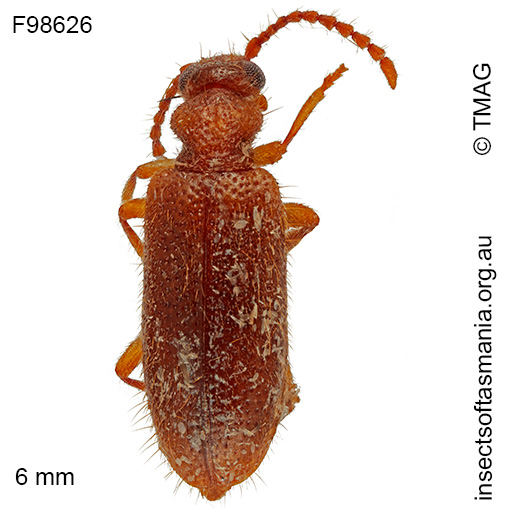
Trichananca victoriensis
Basis for Tasmanian occurrence
TMAG collections
Classification
Order: Coleoptera
Suborder: Polyphaga
Superfamily: Tenebrionoidea
Family: Anthicidae
Subfamily: Lemodinae
Morphology
Typical length (mm): 6
Flightedness: winged and assumed capable of flight
Source literature on morphology and taxonomy (*primary taxonomic source, where identified):
*Blackburn, T. (1891a). Further notes on Australian Coleoptera, with descriptions of new genera and species: IX. Trans. Roy. Soc. S. Aust. 14: 65-193
Ecology
Assumed larval feeding: (not yet documented)
Association with dead wood or old trees: at least facultatively saproxylic
Ecological attributes: — Affiliated with bark on non-wounded trees (Harrison, 2007) — May occupy logs or trunks of Eucalyptus obliqua, at least temporarily, since found having emerged within six years of felling (Grove et al., 2009).
Collection method(s) for TMAG material: — Baited trapping (funnel trap) — Baited trapping (Ips pheromone) — Emergence trapping from log of Eucalyptus obliqua — Knockdown spraying of bark of Eucalyptus sp. — Malaise trapping — Pipe trapping — Pitfall trapping — Sticky trapping (substrate not specified) — Sticky trapping on Eucalyptus obliqua — Vane trapping.
Source ecological literature:
Grove, S.J. (2009b). Beetles and fuelwood harvesting: a retrospective study from Tasmania’s southern forests. Tasforests 18: 77-99.
Grove, S. et al. (2009). A long-term experimental study of saproxylic beetle … succession in Tasmanian Eucalyptus … logs… In: Fattorini, S. (Ed.), Insect Ecology and Conservation. Research Signpost, pp. 71-114.
Grove, S.J. & Yaxley, B. (2005). Wildlife habitat strips and native forest ground-active beetle assemblages in plantation nodes in northeast Tasmania. Aust. J. Entom. 44 (4): 331-343.
Harrison, K.S. (2007). Saproxylic beetles associated with habitat features in Eucalyptus obliqua trees in the southern forests of Tasmania. PhD thesis, Dept. of Zoology, Univ. of Tasmania, Hobart.

